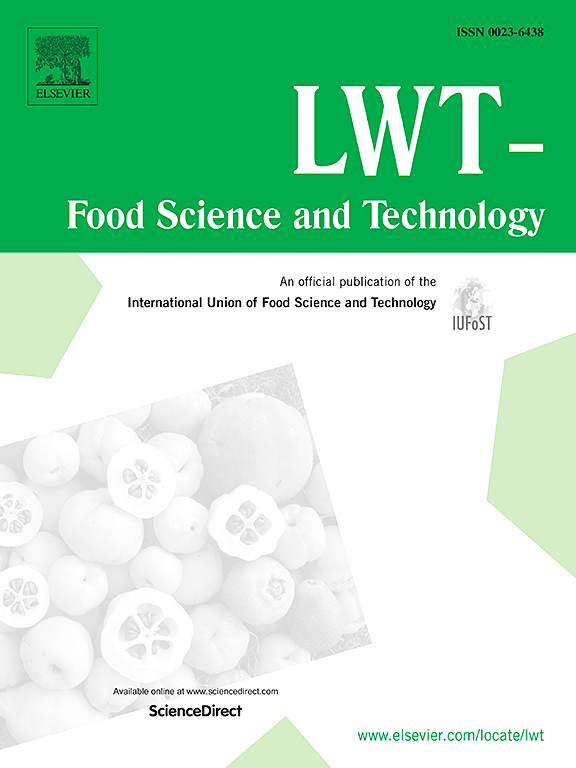富含欧米茄-3 和不饱和脂肪酸的虾油:制备、表征及其在沙拉酱中的应用
IF 6
1区 农林科学
Q1 FOOD SCIENCE & TECHNOLOGY
引用次数: 0
摘要
研究了各种脂肪酶水解条件对从对虾(Litopenaeus vannamei)肝胰脏提取的油(SO)中富集 DHA/EPA 和不饱和脂肪酸(USFAs)的影响。在 20 U 脂肪酶、DMSO 作为溶剂(0.2:0.5)、DMSO 与水作为底物混合物(SM)以及水与 SM(0.在沙拉酱(SD)中添加不同浓度(0、5、10 和 15%)的 n3FAs 和 USFAs 富集虾油(n3SO)(分别为 CON、SD5、SD10 和 SD15),以抵消大豆油的浓度。添加 n3SO 后,沙拉酱呈现出诱人的橙色,提高了沙拉酱的感官特性,其颜色和外观属性的相似度得分均高于 CON 和商用沙拉酱(CM)。添加了 n3SO 的样品显示出更均匀的油滴形态和分布,表明形成了稳定的乳液体系。与 CON 和 CM 相比,n3SO 的粘弹性和流动性也得到了增强,这也支持了上述结果。总之,富含 DHA/EPA 的 SO 可作为 SD 或其他乳液相关产品的潜在补充剂或功能性成分,具有卓越的保健功效。本文章由计算机程序翻译,如有差异,请以英文原文为准。
Omega-3 and unsaturated fatty acid enrichment of shrimp oil: Preparation, characterization, and its application in salad dressings
The effect of various lipase hydrolytic conditions on DHA/EPA and unsaturated fatty acids (USFAs) enrichment of shrimp (Litopenaeus vannamei) oil (SO) extracted from hepatopancreas was investigated. DHA/EPA and USFAs levels increased (40.96/22.61 and 27.83%, respectively) under optimized hydrolytic conditions of 20 U lipase, DMSO as a solvent (0.2:0.5), DMSO to water for the substrate mixture (SM), and water to SM (0.4:1) for 2 h at 50 °C. n3FAs and USFAs enriched shrimp oil (n3SO) were added to salad dressing (SD) at various concentrations (0, 5, 10, and 15%) (CON, SD5, SD10, and SD15, respectively) to offset the concentration of soybean oil. The addition of n3SO imparted an attractive orange color, enhancing the organoleptic properties of the SD, as indicated by higher likeness scores for color and appearance attributes than CON and commercial SD (CM). Samples added with n3SO exhibited a more uniform pattern and distribution of oil droplets, suggesting the formation of a stable emulsion system. The result was also supported by its enhanced viscoelastic and flow properties than the CON and CM. Overall, DHA/EPA enriched SO could be potential supplement or functional ingredient in SDs or other emulsion related products with superior health benefits.
求助全文
通过发布文献求助,成功后即可免费获取论文全文。
去求助
来源期刊

LWT - Food Science and Technology
工程技术-食品科技
CiteScore
11.80
自引率
6.70%
发文量
1724
审稿时长
65 days
期刊介绍:
LWT - Food Science and Technology is an international journal that publishes innovative papers in the fields of food chemistry, biochemistry, microbiology, technology and nutrition. The work described should be innovative either in the approach or in the methods used. The significance of the results either for the science community or for the food industry must also be specified. Contributions written in English are welcomed in the form of review articles, short reviews, research papers, and research notes. Papers featuring animal trials and cell cultures are outside the scope of the journal and will not be considered for publication.
 求助内容:
求助内容: 应助结果提醒方式:
应助结果提醒方式:


